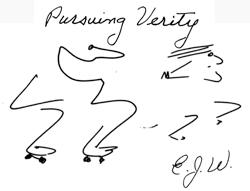Former FBI agent and retired criminal justice professor Jim Fisher is also a well-known author. A graduate of Vanderbilt University Law School, he has published nine non-fiction crime books, two of which have been nominated for Edgar awards.
He writes prolifically, engagingly, and sometimes pugnaciously about true crime on his blog at http://jimfishertruecrime.blogspot.com/ . I don’t always agree with him, but I consistently find his blog absorbing.
He has kindly answered some questions for me at EJdissectingRoom.
Knowing that Jim has written extensively on polygraph “lie detector” examinations, I asked him:
EJ: There have been cases in which individuals holding sensitive positions at both the FBI and the CIA, have passed polygraphs given by highly trained examiners, only to be later exposed as foreign agents. How difficult is it, in your opinion, to train some one to cheat the test?
Jim Fisher: Errors in the polygraph procedure are almost always human. The instrument itself, assuming the correct questions have been asked and the subject is suitable for the polygraph, rarely fails to detect deception. Polygraph examinees can do things that will make the results inconclusive, but that’s not the same as beating the polygraph.
EJ: Do you believe results of polygraph should be admitted in court?
Jim Fisher: Polygraph results should not be used in court as evidence of a defendant’s guilt. These instruments, however, are valuable investigative tools and should be used in that context. . . .
I do not believe that criminal suspects should be required by law to take a polygraph. The polygraph technique will not work unless the test is voluntary.
In his blog, Jim has also commented on crime laboratory problems.
EJ: Shortage of forensic pathologists, adequately funded crime labs, and lack of uniform standards in the forensic sciences present huge problems. What are your thoughts on improving this situation?
Jim Fisher: The shortage of forensic pathologists is a problem that has resisted solutions for decades and I don’t see that changing. Crime labs, due to the economy, will remain under-funded. Unless the federal government gets involved, I don’t see uniformity in the forensic services.
Writing about the recent film biography of J. Edgar Hoover, Jim describes his own stint with the FBI in less than happy terms. . . .
EJ: In your blog discussion of your time in J. Edgar Hoover’s FBI, you mentioned that leaving the organization felt “like getting out of prison.” Given the extremely controlling atmosphere under Hoover’s administration, what made many good people willing to submit to the regimen?
Jim Fisher: Out of my FBI training class of 50 agents in 1966, all but thirteen stayed in the bureau until retirement. All of the 13 agents who left before then had law degrees. Agents put up with J. Edgar Hoover because they could retire at age 50 with good benefits.
Aware that Jim has written on the Lizzie Borden unpleasantness and other historical classics, I asked:
EJ: Of the myriad “Crimes of the last Century” which do you find most intriguing? Why?
Jim Fisher: My favorite 20th Century “crimes of the century” are: The Lindbergh kidnapping (1932-1936); The Sacco and Vanzetti Case (1991-1927) and the Hall-Mills Case (1926). I like cases that hinge on forensic science and the interpretation of physical evidence.
[These are all American cases.
In March of 1932 the twenty month old son of aviation hero Charles Lindbergh was snatched from the nursery at the family home in New Jersey. The child’s body was found in a wooded area two months later. Extensive physical evidence heavily implicated Bruno Richard Hauptman , who was convicted and executed for the crime.
Sacco and Vanzetti involved a double shooting murder in Massachusetts for which Italian immigrants Nicola Sacco and Bartolomeo Vanzetti were executed in August of 1927. The case had political overtones and attracted international attention.
The atmospheric Hall-Mills Case remains officially unsolved. The bodies of a minister and his choir singer lover were discovered supine under a crab apple tree on Lover’s Lane in New Brunswick, New Jersey in September of 1922. Love letters from the murdered woman to the minister were scattered about the crime scene. The resulting investigation involved, among other things, the testimony of a former maid in the minister’s household, that of a lady who raised hogs and was known therefore as “The Pig Woman” and fingerprint evidence. The betrayed widow of the minister and her two brothers were tried for the murders in 1926 but acquitted.
– EJDissectingRoom]
Sherlock Holmes was a collector of criminal history and advises in The Valley of Fear “. . . to shut yourself up for three months and read twelve hours a day at the annals of crime.”
EJ: Do you agree with Mr. Holmes that the study of old cases is of value to modern investigators?
Jim Fisher: I discovered the works of Arthur Conan Doyle (Sherlock Holmes) in adulthood…. Sherlock Holmes was right. To know the future of crime you must know it’s history. Studying old cases and how they were solved or bungled is an excellent teaching tool.
[The last word belongs to Mr. Holmes (in The Valley of Fear):
“Everything comes in circles . . . The old wheel turns, and the same spoke comes up. It’s all been done before, and will be again.” – EJDissectingRoom]
You can visit Jim’s intriguing crime blog at http://jimfishertruecrime.blogspot.com/.
Still pursuing verity,
E. J. Wagner

Tags: Arthur Conan Doyle, crime lab, crime of the century, FBI, forensic pathologists, forensic science, Hall-Mills, J. Edgar Hoover, Lindbergh kidnapping, polygraph, Sacco and Vanzetti, Sherlock Holmes
Leave a comment